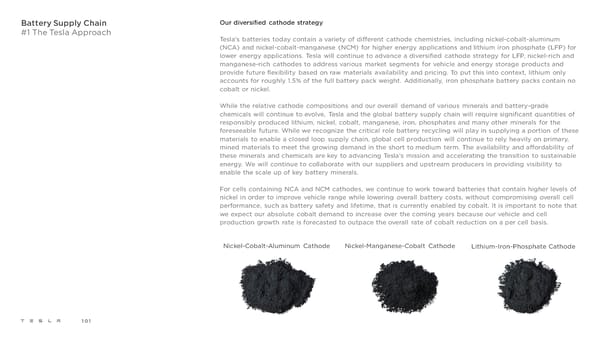Battery Supply Chain Our diversified cathode strategy #1 The Tesla Approach Tesla’s batteries today contain a variety of different cathode chemistries, including nickel-cobalt-aluminum (NCA) and nickel-cobalt-manganese (NCM) for higher energy applications and lithium iron phosphate (LFP) for lower energy applications. Tesla will continue to advance a diversified cathode strategy for LFP, nickel-rich and manganese-rich cathodes to address various market segments for vehicle and energy storage products and provide future flexibility based on raw materials availability and pricing. To put this into context, lithium only accounts for roughly 1.5% of the full battery pack weight. Additionally, iron phosphate battery packs contain no cobalt or nickel. While the relative cathode compositions and our overall demand of various minerals and battery-grade chemicals will continue to evolve, Tesla and the global battery supply chain will require significant quantities of responsibly produced lithium, nickel, cobalt, manganese, iron, phosphates and many other minerals for the foreseeable future. While we recognize the critical role battery recycling will play in supplying a portion of these materials to enable a closed loop supply chain, global cell production will continue to rely heavily on primary, mined materials to meet the growing demand in the short to medium term. The availability and affordability of these minerals and chemicals are key to advancing Tesla’s mission and accelerating the transition to sustainable energy. We will continue to collaborate with our suppliers and upstream producers in providing visibility to enable the scale up of key battery minerals. For cells containing NCA and NCM cathodes, we continue to work toward batteries that contain higher levels of nickel in order to improve vehicle range while lowering overall battery costs, without compromising overall cell performance, such as battery safety and lifetime, that is currently enabled by cobalt. It is important to note that we expect our absolute cobalt demand to increase over the coming years because our vehicle and cell production growth rate is forecasted to outpace the overall rate of cobalt reduction on a per cell basis. Nickel-Cobalt-Aluminum Cathode Nickel-Manganese-Cobalt Cathode Lithium-Iron-Phosphate Cathode P 101
 Tesla 2021 Impact Report Page 100 Page 102
Tesla 2021 Impact Report Page 100 Page 102